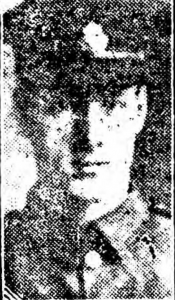
BORN HULL 1896. SON OF ROBERT MUSSETT (1856-1911) AND FRANCES ELLEN RIX (1856-1904). A KEG MAKER. HE WORKED FOR THS SISSON BROTHERS AND WAS MEMBER OF THE KINGS HALL CHURCH. HE RESIDED AT 17 GEORGE AVENUE, LAKE STREET, HULL.
HE ENLISTED IN HULL, ON 11/12/1915, AGED 19 YEARS AND 7 MONTHS. HIS ARMY MEDICAL RECORDS DESCRIBED HIM AS 5 FOOT, 8 INCHES TALL, 34.5 INCH CHEST, 145 LBS WEIGHT. POSTED TO FRANCE, ON 06/05/1916. SERVED WITH THE 8TH EAST YORKSHIRE REGIMENT. KILLED IN ACTION, ON 14/07/1916. HE HAD SERVED IN THE ARMY FOR 217 DAYS. HE IS COMMEMORATED ON THE THIEPVAL MEMORIAL, TO THE MISSING ON THE SOMME. HIS NAME WAS RECORDED ON THE ON LAKE STREET, ROLL OF HONOUR. (NB: J MUSSETT – KINGS HALL CHURCH ROH, SYMONS STREET, HULL)
HIS NEXT OF KIN, WAS HIS BROTHER, JAMES HENRY MUSSETT, AT 77 GRANGE STREET, HULL, WHO DIED IN MARCH 1918. HE SHARED HIS ARMY EFFECTS WITH ALL HIS SIBLINGS, GEORGE, WALTER, ROBERT, JOHN, ELIZABETH, EMMIE AND FRANCES, AT 63 CHILTERN STREET, HULL. HIS BROTHER, ROBERT SERVED IN THE ROYAL ARMY MEDICAL CORPS AND WAS SERVING IN FRANCE, AT THE AGE OF 16. HE IS PHOTOGRAPHED IN THE HULL DAILY MAIL ON 25/08/1916. *.
Somme – The 8th East Yorkshires spent the following weeks alternating between resting, training, and spells in the line near Dickebusch, while preparations went on further south for that summer’s ‘Big Push’ (the Battle of the Somme). The battalion entrained for the Somme on the day the offensive began, 1 July. It went into brigade reserve when 3rd Division took over the Caterpillar Wood sector near Montauban, providing carrying parties and night patrols. After the disasters of the first day, 3rd Division in conjunction with three others was to make a daring night assembly and dawn attack on 13/14 July (the Battle of Bazentin Ridge). The Brigade Intelligence Officer had placed a screen of picquets and scouts out in No man’s land within 200 yards (180 m) of the enemy line and the assaulting troops slowly moved up in the hours of darkness to a sunken lane just short of this line. They then moved forwards 15 yards every 15 minutes until they were on their jumping-off tapes about 120 yards (110 m) from the enemy by 03.15; 8th EYR was on the right of 8th Bde’s line, with half of 1st Royal Fusiliers in support. At 03.20 a sudden intense bombardment was placed on the German barbed wire and trenches and five minutes later the whole attacking line of four divisions advanced behind a Creeping barrage. Along most of the line the German resistance was feeble; unfortunately the wire in front of 8th Bde was hardly touched, there were just a few breaks in the first belt and none in the second. Two platoons of the 8th EYR managed to get through on the right, the remainder had to shelter in shell holes in front of the wire or retire to the sunken road. Lieutenant-Colonel Way was wounded in the wire and Maj Brewis came up to take temporary command once more. Later a bombing party from 2nd Royal Scots came down from the left and cleared the Germans out of the trench in front of the battalion, but of the two platoons that had penetrated, no more was heard. In what was largely a successful British attack, the battalion had suffered severely, with 8 officers killed and 11 wounded, 81 other ranks killed, 218 wounded, and 141 missing, over half the initial strength of the battalion. Even when the battalion took over the opposing trenches they were heavily shelled with high explosive (HE) and gas until they were relieved on 20/21 July 1916.
